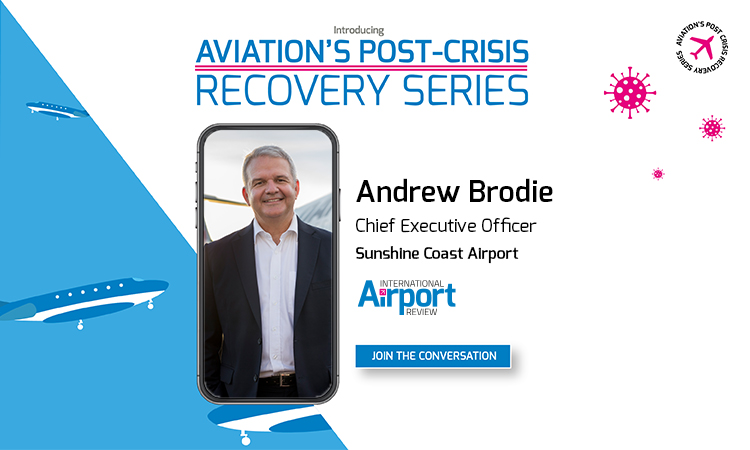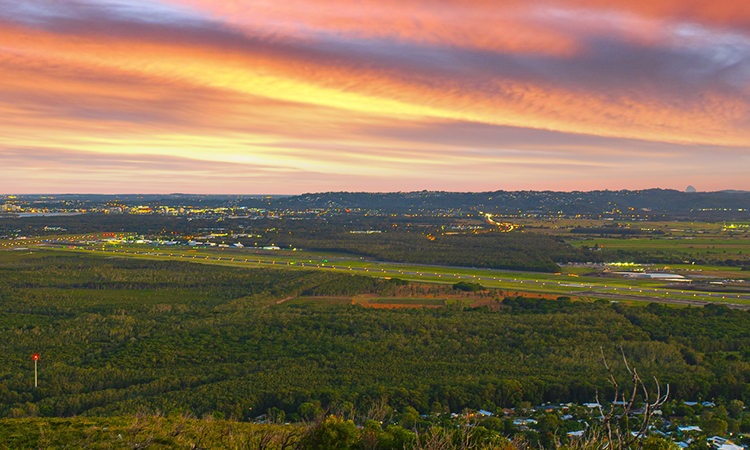Aviation’s Post-Crisis Recovery Series: Sunshine Coast Airport
- Like
- Digg
- Del
- Tumblr
- VKontakte
- Buffer
- Love This
- Odnoklassniki
- Meneame
- Blogger
- Amazon
- Yahoo Mail
- Gmail
- AOL
- Newsvine
- HackerNews
- Evernote
- MySpace
- Mail.ru
- Viadeo
- Line
- Comments
- Yummly
- SMS
- Viber
- Telegram
- Subscribe
- Skype
- Facebook Messenger
- Kakao
- LiveJournal
- Yammer
- Edgar
- Fintel
- Mix
- Instapaper
- Copy Link
Posted: 30 April 2021 | Andrew Brodie | No comments yet
Sunshine Coast Airport’s CEO, Andrew Brodie, reflects on the changes brought about by the unprecedented pandemic, and speaks of the strengths and positives that have evolved from that adversity which are guiding the airport’s future in the latest instalment of International Airport Review’s exclusive series.


The COVID-19 pandemic has been completely unprecedented in its impact on the aviation industry. How has it impacted Sunshine Coast Airport?
2020 wasn’t what we had planned. We had expected it to be a year of growth for our airport. The Sunshine Coast, in Queensland’s south east, is one of Australia’s regional economic powerhouses. It is also one of the country’s most popular domestic holiday destinations, experiencing record visitor numbers in 2019.
We had been working towards commissioning a new $334 million internationally capable runway in mid-2020, and we were positioned to increase our network of destinations across Australia and into Asia for the first time.
Happily, 12 months on, we have been able to bring our furloughed staff back into the business and we are forecasting that we will be above our pre-COVID-19 capacity for the month of April 2021″
In Australia, the federal government announced a lockdown in March 2020, which meant that leisure travel stopped overnight. State governments, including Queensland, restricted movement further, by introducing border closures between states for the first time in 100 years.
We were cut off from our key markets in Sydney and Melbourne and went from being Australia’s fastest growing airport in 2019 to effectively closing our terminal doors for three months at the end of March 2020, as airlines suspended flights to the Sunshine Coast. Our revenue plummeted by 97 per cent, and we were forced to make some hard decisions regarding our staff, standing about half down from duties (furloughed) until economic conditions improved.
Happily, 12 months on, we have been able to bring our furloughed staff back into the business and we are forecasting that we will be above our pre-COVID-19 capacity for the month of April 2021.
What immediate changes did you have to make in response to the pandemic, and what did you find the hardest problem to tackle?
The most immediate and toughest decisions we needed to make were in relation to our staff. What would we do with our 50 employees, many operational or customer-facing, when we closed the terminal and had no meaningful work for them in the context of a 97 per cent reduction in revenue?
We worked extremely hard to keep our staff engaged and connected with the business while they were stood down, with a big focus on communications and wellbeing”
We worked extremely hard to keep our staff engaged and connected with the business while they were stood down (furloughed), with a big focus on communications and wellbeing.
It was also essential that we reduce our cost base, and we managed to do that by more than 50 per cent by taking the time to review our contracts and operating costs while ensuring that compliance and safety was not affected.
We were also in the final months of the construction of our new, internationally capable runway, which was to be commissioned in June 2020. This was a big focus for our team, despite not knowing when we would see jet traffic back at the airport or, indeed, not knowing when international travel would be possible.
I’m really proud of what our team achieved in that difficult six months. We managed to commission the new runway safely, attract a new intrastate service to Cairns and reactivate our terminal in a COVID-safe way.
What initiatives are you focusing on during 2021 to rebuild passenger confidence?
Sunshine Coast and Noosa are among Australia’s premier visitor destinations, and we believe that its popularity will only grow, given that we are spoilt with beautiful beaches, national parks and plenty of open space. We were fortunate enough to have a low number of COVID-19 cases, so we are perceived as a safe destination by travellers.
We expect a lot of pent-up travel demand, particularly with visitors from the southern states who were subject to longer lockdowns.
We expect a lot of pent-up travel demand, particularly with visitors from the southern states who were subject to longer lockdowns”
We’ve done a lot of work to make our terminal a safe environment, which led to us receiving the Airports Council International (ACI) COVID-safe Airport Health Accreditation.
The biggest challenge for the Sunshine Coast, and other Queensland destinations, is building confidence that state borders won’t close in response to an outbreak and see travellers stranded away from home. We welcome the more measured response to border closures and expect that traveller confidence will only increase as the vaccine is rolled out.
There has also been a strong focus on environment and sustainability from our airport users, particularly given that we are nestled between beautiful beaches and national parks. This is still very important to our passengers, so we’ve worked to maintain our status as Australia’s first and only carbon neutral airport and, indeed, are looking at what more we can do.
What other exciting projects/developments are in the pipeline at Sunshine Coast Airport to help cope with increased passenger numbers once air travel begins to pick-up again?
We are looking forward to seeing our new, international runway put to good use in the coming years. At the time of writing, we are eagerly awaiting steps towards a ‘Trans-Tasman travel bubble’ with New Zealand, which will allow for quarantine-free travel between both countries.
Prior to COVID-19, we were planning a terminal redevelopment over the next three to five years to cater for the passenger growth that we had anticipated in both domestic and international travel due to the new runway.
As we approach COVID-19 capacity levels, we have recommenced the planning work towards that terminal redevelopment. In the meantime, however, we are also looking at some interim terminal enhancements in the check-in, departure lounge and baggage reclaim areas of our airport.
We are also working on infrastructure upgrades to our screening facilities in order to deliver the mandatory screening requirements, including body scanners, by the deadline of 2022.


Credit: Sunshine Coast Airport – MCY’s runway.
Are there any initiatives that you have implemented during the COVID-19 pandemic that you will permanently integrate into your airport’s strategy, even once the crisis has passed?
For us, what the impacts of COVID-19 demonstrated was the need for Sunshine Coast to diversify its revenue streams. The airport site is around 460 hectares, with only about half in use for aviation.
Our overarching Master Plan, developed in late 2019, outlines proposed uses for the site, including a vibrant aviation industry leveraging the new runway, commercial opportunities and environmental initiatives, such as solar arrays. This involves a $200 million capital programme, which, unfortunately, was put on hold due to COVID-19. We are now pursuing those opportunities with renewed urgency, including a freight and logistics hub, as well as industrial, commercial, convenience and retail uses.
For us, what the impacts of COVID-19 demonstrated was the need for Sunshine Coast to diversify its revenue streams”
There are almost 7,000 primary producers in our greater region, from award-winning seafood – such as tuna and swordfish – to dairy – such as cheese – and more niche products, such as finger lime (think lime caviar). Again, COVID-19 has meant that people have taken the time to really think about the source of what they are eating, and valuing produce from a clean, green environment like the Sunshine Coast.
We’ve been exploring what might be possible with our local food and agricultural network, and we are even looking at establishing Australia’s first circular and collaborative food and beverage (F&B) manufacturing hub, co-located with our new freight hub, which will allow our growers to take their produce, value add through a manufacturing process and get it into the best restaurants and stores in Australia first and, when the time is right, internationally.
We believe that more diverse land use will mean a more diverse economy and more robust revenue streams for our airport in the future.
What business activity are you forecasting for Sunshine Coast Airport/ what is your business outlook?
We are confident in the rebuilding of aviation at Sunshine Coast Airport (MCY). We have an amazing region, which was the fastest growing visitor destination in Queensland in 2019.
Out of adversity, good things happen. What we have seen is a change in how the airlines view our region, and we’re noticing that they are doing different things”
Out of adversity, good things happen. What we have seen is a change in how the airlines view our region, and we’re noticing that they are doing different things.
We have worked hard to broaden the destinations offered from Sunshine Coast and, since mid-2020, have doubled the destinations served by adding Cairns, Canberra, Newcastle and Emerald to our existing Sydney, Melbourne and Adelaide routes. These new routes are being operated by some of the smaller airlines and have a strong focus on major regional centres, as we think that they will be increasingly important as people look at a tree or sea change in pursuit of a different lifestyle.
We’re also seeing more capacity added for our city routes, too – with a second carrier coming on board for Adelaide and Qantas offering a two daily service to Melbourne and Sydney for the first time in many years – in order to meet the demand of the business market.
Related topics
Aeronautical revenue, Air freight and cargo, Airport Carbon Accreditation (ACA), Airport construction and design, Airport crisis management, Airside operations, Aviation's Post-Crisis Recovery Series, COVID-19, Emissions, Non-aeronautical revenue, Passenger experience and seamless travel, Passenger volumes, Runways and pavements, Safety, Sustainability, Sustainable development, Terminal operations, Workforce


















